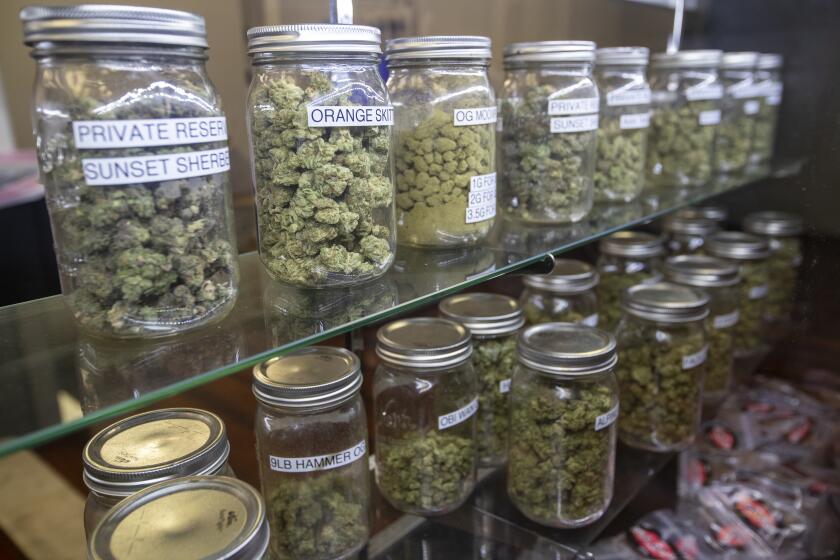EPA Criticized for Not Toughening Soot Law
As many as 24,000 lives -- a large number of them Californians’ -- could have been saved each year if the head of the Environmental Protection Agency had tightened soot standards by one microgram per cubic meter annually, according to an analysis released Friday.
The cost-benefit analysis also shows that although the tab for power plants, refineries, auto manufacturers and other industry for such a change would be about $1.9 billion a year -- or about $15 per household -- the savings in healthcare costs, work and school attendance and other benefits would be between $4.3 billion and $51 billion.
Exposure to soot, or fine particulate matter, has been repeatedly linked to respiratory and cardiac illness and premature death. Southern California and the San Joaquin Valley have the worst fine particulate pollution in the nation, largely because of diesel-powered vehicles. The estimates found as many as 6,400 lives would be saved annually in California.
By law, the EPA is not allowed to consider the costs of a new regulation. But it, along with all other federal agencies, is required to calculate them. The agency is required to consider health benefits.
EPA administrator Stephen Johnson has been harshly criticized by medical groups, environmentalists and his own science advisors for his Sept. 21 decision to retain a standard allowing annual exposure of 15 micrograms per cubic meter, rather than tightening it to 14 micrograms or fewer.
The American Medical Assn., the American Lung Assn., pediatric and environmental groups and scores of doctors and academics who specialize in heart and lung disease had asked Johnson to set a standard of between 12 and 14 micrograms per cubic meter of air for fine particulates, saying that study after study had shown a correlation between increased exposure to soot and higher numbers of illnesses and deaths.
Friday’s online posting unleashed a new round of criticism.
“It’s pretty sobering and shocking stuff to realize the agency concluded the human cost of refusing to strengthen these air quality protections was going to be [thousands of lives] lost each year,” said attorney John Walke, the clean air director for the Natural Resources Defense Council.
Walke said that although the cost to industry “is not insignificant ... it pales in comparison to the $50 billion annually that they project will be incurred in healthcare costs as a result of the failure to upgrade the standards.”
“It’s pretty darned obvious that better standards would mean fewer premature deaths,” said Frank O’Donnell of Clean Air Watch.
Industry representatives could not be reached for comment late Friday.
Johnson did significantly tighten daily exposure amounts to soot, cutting the allowable level from 65 to 35 micrograms, which electric industry representatives in particular had criticized as being of unproven need and costly. The same analysis released Friday shows as many as 13,000 lives will be saved as a result of that change, at a cost of $5 billion annually, with $9 billion to $76 billion in social benefits. Johnson was not available for comment Friday. He said at the time of his decision that “reasonable minds can disagree” and that there was disagreement among scientists on the evidence concerning annual particulate exposure.
But the analysis released Friday shows that every member of a 12-member panel of scientists convened at the request of the White House Office of Management and Budget and National Academy of Sciences found that thousands of additional lives could be saved if the tougher annual standard were adopted.
The panel was made up of authors of the studies that Johnson used and specialists picked by their peers as the leading experts in particulate pollution. All reviewed the available literature on soot illness and death and primarily relied on the same two studies that Johnson did in making their estimates.
“I feel that he didn’t really take into account the best available science, which is now saying very clearly that there are very significant health effects related to this longer-term exposure,” said Dr. Bart Ostro, one of the 12 panelists and chief of the air pollution epidemiology section for the California EPA.
Ostro said the science panel had set risk percentages of increased illness and mortality, which the EPA then converted into possible deaths based on U.S. population and total death rates. Under a limit of 14 micrograms, those estimates found a range of lives saved from 2,200 to 24,000, or an average 13,000 annually. In all cases, the highest number of deaths avoided would be in California.
Ostro said that because California has the most fine particulate pollution and a large population, “we would see a large chunk of the benefits” if the standard were set at 14 micrograms.
“We’re talking about ... hospitalization and emergency room visits, asthma attacks and work loss as well as mortality,” he said.
Acting assistant EPA administrator William Wehrum, who worked with Johnson on the new rules, said Friday that the new analysis was not ready when Johnson made his decision, so it was not included as part of that process. But it would be helpful in future regulations, he said, adding that Johnson and agency staff “absolutely considered impacts to human health.”
More to Read
Sign up for Essential California
The most important California stories and recommendations in your inbox every morning.
You may occasionally receive promotional content from the Los Angeles Times.










